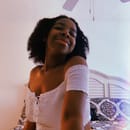I spent the first eight years of my life being natural. By natural, I mean no chemicals, dyes or strong treatments have ever touched my hair. I also grew up “tender-headed,” so the comb running through my thick hair was excruciating—sounds dramatic, but my scalp is sensitive—and the pulling involved in the detangling process was no joke. This frustrated my mom, who spent that time detangling and styling my hair. She decided it was time for me to get a relaxer. A relaxer is a hair treatment commonly used among Black women that involves strong chemicals loosening the curls to leave the hair pin-straight for an extended amount of time. As a result, my mom saved time and reduced the stress of my wash day routine and daily styles.
At first, I thought the relaxer was an ally. My hair stretched and almost reached my back within a couple of years. What I hadn’t anticipated was the breakage my hair would endure soon after. It was a tough process for me to maintain my relaxed hair, and if I had missed a hair appointment—well, then good luck! As my hair got shorter and shorter, I started exploring different protective styles such as braids, twists and extensions. The beauty of Black hair is the ability to adapt and change styles every so often, but what I had to keep in mind was to let my hair breathe at some points to allow for growth and to heal the breakage.
Upon entering college, I had still been relaxing my hair. During my first summer semester, I decided I wanted extensions with minimal leave out (some of my real hair still being visible). I continued to relax my hair because I needed it to match the texture of my extensions. Eventually, I realized that I didn’t have the best understanding of how to keep my hair healthy and promote growth. My mom has a completely different hair texture, and it was hard for her to style my hair since she had never experienced it before.
My confidence had begun to dwindle as I felt increasingly less connected to the hair on my very head. My roommate would try to help me since we had similar hair textures, but I still felt clueless. A girl I often crossed paths with caught my eye on campus because of how neat her natural hairstyles looked. It was empowering to see a woman with similar hair texture embrace her natural hair and seem so radiant with it. I approached her to ask her how she went natural and what her journey looked like. Something I deemed comical at the moment but resonated with me was when she said that every Black girl goes natural in college. I was new to this space, so I thought she was exaggerating, but I then started to notice the trend.

My journey officially began by cutting my hair during my freshman year. I hadn’t felt fully comfortable rocking my short, natural hair, so I dabbled in protective styles. As I implemented more techniques to retain moisture and style my natural hair, I started seeing the beauty in my hair. I was able to rejoice in owning my hair again and felt my self-confidence growing. The journey continues as I find new products and test different styling methods to find what’s best for me but taking the plunge has been one of the most fulfilling things as a Black woman. I urge you to go for it if you are thinking of going natural because there are so many resources out there to guide you during this journey!
Want to see more HCFSU? Be sure to like us on Facebook and follow us on Instagram, Twitter and Pinterest!



